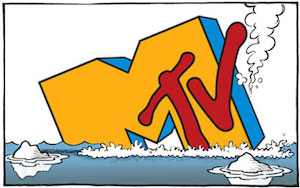 Three decades ago Madonna appeared on MTV in a wedding dress, writhing on the floor, seductively singing Like a Virgin at the MTV Video Music Awards (VMAs). America gasped… and begged for more.In a world without smartphones, MTV owned a generation of young people.
Three decades ago Madonna appeared on MTV in a wedding dress, writhing on the floor, seductively singing Like a Virgin at the MTV Video Music Awards (VMAs). America gasped… and begged for more.In a world without smartphones, MTV owned a generation of young people.
Now… they don’t.
In fact, this year MTV lost about a third of their VMA viewership compared to last year’s show, by far their biggest drop in history.
Why?
The writing has been on the wall for several years now.
Music Videos and Reality TV
In the early years MTV was the place to go for music videos. Kids would get home from school, throw their backpacks on the floor, plop on the couch, check their pagers… and turn on MTV. MTV was the place to be.
MTV founder and chairman Robert Pittman’s famous quote reveals a little about the channel’s incredible impact on youth culture:
- “We don’t shoot for the fourteen year olds, we own them.” (Understanding Today’s Youth Culture, Walt Mueller, page 81)
Soon, MTV switched their programming focus from music videos to reality shows, and young people readily followed. In fact, MTV was the go-to-place for reality shows. Name it: The Real World, Tila Tequila…The Jersey Shore.
And once a year MTV delivered the VMAs—the most accurate annual porthole into today’s pop culture (we would write about it each year). Every pop culture icon was present as unfiltered as TV would allow. Each year the VMAs would try new scandalous display to draw viewers.
And it worked.
In 2003 Madonna kissed Britney, a ploy making the front page of every news source in the weeks to follow. Year after year MTV tried harder. In 2011 Lady Gaga showed up in drag, and it drew the largest audience to date. This was a time when MTV still “owned” young people. In fact, at that time they provided the No. 1 show watched by 12-17-year-olds, Jersey Shore.
And then it happened.
Everything went mobile.
The Rise of the Small Screen
In 2012 American Smartphone permeation passed the 50% mark. In September 2012 Nielsen reported 58% of teens owning a smartphone, compared to just 36% the year prior—a huge leap! This created a noticeable shift where young people spent their time. Within a year (by 2013) we saw most Americans spending over 2 hours a day on mobile devices alone.
If young people wanted to watch a music video, they could watch it whenever they wanted… wherever they were. They didn’t need MTV. If they wanted to watch college kids get drunk and argue, they didn’t need to visit The Jersey Shore, they could find it on YouTube.
And MTV began losing its young audience.
Don’t get me wrong. I’m not saying all of television lost its young audience. Most recent reports still show TV as the No. 1 media activity by tweens, and the No. 2 activity by teens (second only to “listening to music”). But much of this media use is highly mobile. Netflix binging is changing entertainment.
Somehow along the way MTV lost its appeal. MTV no longer owned reality shows. The networks did… and still do. (America’s Got Talent, The Voice…). And when kids weren’t turning to MTV day in and day out, they seemed to forget about the VMAs. After all, you could just watch the clips online the next day if anything outrageous happened.
A year ago the 2015’s VMAs revealed this trend, with a decrease in television viewers, but an increase in social media activity. Viewership was down despite MTV’s efforts to broaden the audience, showing it on 9 Viacom networks. But regardless of the dip in numbers, social media chatter about the event exploded, even breaking records on Twitter. In other words—young people didn’t watch the show, but when they heard about Miley’s “indecent exposure” they jumped to their mobile devices to watch, link, post and comment.
If MTV thought 2015 was just a small dip in television viewership, they experienced a rude awakening in 2016 when their numbers plummeted downward by a third. Cruel headlines emerged in the days to follow, like “Basically, Nobody Cares About 2016 MTV Video Music Awards.”
The VMAs had lost their draw.
I guess young people didn’t want to sit through another Kanye West speech.
The question many are asking is… who owns 14-year-olds today?
YouTube?
Snapchat?
The Voice?
Will we ever see one pop-culture-giant emerge again like MTV?
Who has the eyes and ears of your kids?
Jonathan McKee
Jonathan McKee is the author of over twenty books including the brand new The Guy's Guide to FOUR BATTLES Every Young Man Must Face; The Teen’s Guide to Social Media & Mobile Devices; If I Had a Parenting Do Over; and the Amazon Best Seller - The Guy's Guide to God, Girls and the Phone in Your Pocket. He speaks to parents and leaders worldwide, all while providing free resources for parents on his website TheSource4Parents.com. Jonathan, his wife Lori, and their three kids live in California.



